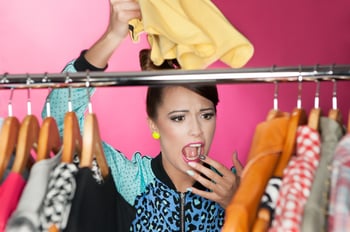We all judge people based on the way they are dressed.
If a guy walked into your shop and saw you dressed in white makeup, wild red hair, clown shoes, a red nose, baggy colorful pants, a bunch of balloons, and a painted-on smile, he'd probably quickly decide this guy is a clown.
That’s because customers judge you within nanoseconds of spotting you. Your good looks, warm personality, and product knowledge will have to wait until they decide whether to trust you.
And that happens based on your clothing - whether you are behind the counter, working with a customer, or just returning from a break.
When we meet a stranger, we all play a sorting game. What we find perfectly acceptable in an average department store is a step below Nordstrom.
Dress codes were created because some team members didn't notice any differences.
And that's a problem...
Because if customers don't trust you and don’t feel you represent the brand, they won’t trust anything you say about fit, appropriateness, or style. Instead, they'll trust their friends on Instagram and cut the employee out of the buying cycle.
And that’s not good if customers don’t trust you…
According to this blog JC Penney's changed its dress code to: “jeans, t-shirt, and clean tennis shoes. R.I.P. the tie and dress shirt, goodbye to dresses and pantyhose, and farewell to high heels and dress pants. You will all be missed dearly - imagine having a lady in a t-shirt and jeans, no makeup or perfume, fit you in a bra. Now someone like this [sic] giving advice on how to wear a prom dress and what shoes to wear with it.”
If you're a teen retailer, dress codes might not need to be strict, but if you sell luxury watches, clothing, or services, your sales associate needs to be seen as a player immediately. That means for a luxury brand, they aren't just wearing a suit, but an Armani.
Boomer customers dropping off their most precious jewelry pieces want to see people they trust and believe in. They won’t trust a 20-something dressed casually and are still adapting to some visible piercings.
Prioritizing brands you already know can help you quickly grasp this concept and apply it to your retail management practices. To that end, I present my Levels of Dress Code.
The 8 Levels of Dress Code:
-
Tiffany’s – Designer suiting
-
Your bank – Business suiting
-
Nordstrom – Business casual
-
Macy’s – Casual with guidelines
-
Penney’s - Casual
-
Convenience Store - Street clothes
-
Apple – Branded T-shirt
-
Fast food - Uniform
Notice the highest levels allow employees more personalization to stand out as individuals. As you move down the scale to uniforms, the employees become more faceless. No one sticks out, and anyone can help you.
Overdressing
On the other hand, you could be wrong if you require everyone to outfit themselves in business wear - outside of Manhattan. By encouraging a dress code policy that includes the traditional suit and tie, your employee may make customers feel judged or that specific customers "aren't good enough to shop there." That's dangerous because your retail store crew will have to work even harder to break down the barriers between strangers to get the customer to trust them.
For most areas, guys can lose the tie.
But overdressing is much less dangerous than having your employees look worse than the average luxury, i.e., Boomer customers, who still have money, expect when they shop.
Part of setting yourself apart comes when customers walk in your doors. Suppose you are a women's apparel store and employ a sales associate who dresses sloppily, with haphazard prints and dirty shoes instead of more appropriate attire. Will she ever be able to sell your best wear? Doubtful because she can be judged as someone untrustworthy in that setting.
You should dress one level up if you are the owner or manager. It affects your confidence, and you’ll look like someone in charge. Customers like that.
It may be shallow, but the old five-second rule is very much alive. When strangers first meet you, they subconsciously presume your social class, education, income, and intelligence by simply viewing your attire. The clothing choices one makes to go to the workplace signal one's interest in the job, one's respect for the brand, and even one's level of wanting to succeed in that job.
Once you open your mouth, you can prove those judgments right or wrong, but you may never get that chance as customers avoid those they don’t trust.

